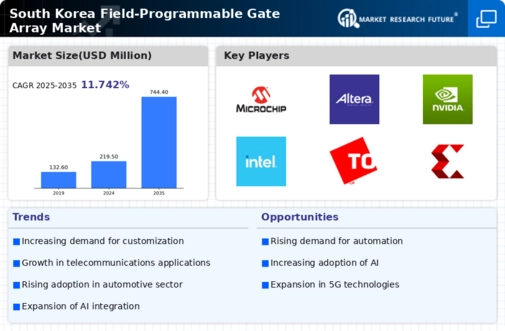Technological Advancements in FPGA Design
The field programmable-gate-array market in South Korea is experiencing a surge due to rapid technological advancements in FPGA design. Innovations such as improved architecture and enhanced processing capabilities are enabling the development of more efficient and powerful FPGAs. This evolution is particularly evident in sectors like telecommunications and automotive, where the demand for high-performance computing is critical. As of 2025, the market is projected to grow at a CAGR of approximately 10%, driven by these advancements. Companies are increasingly investing in R&D to create FPGAs that can handle complex algorithms and data processing tasks, thereby expanding their applications. The field programmable-gate-array market is thus poised for significant growth as these technologies become more mainstream.
Increased Adoption in Consumer Electronics
The field programmable-gate-array market is witnessing increased adoption in consumer electronics within South Korea. As devices become smarter and more interconnected, the need for customizable hardware solutions is rising. FPGAs offer flexibility and adaptability, allowing manufacturers to tailor their products to meet specific consumer demands. This trend is particularly prominent in smart home devices, wearables, and gaming consoles, where performance and efficiency are paramount. The market for consumer electronics is expected to reach $30 billion by 2026, with FPGAs playing a crucial role in this growth. The field programmable-gate-array market is thus benefiting from this shift towards more personalized and efficient electronic solutions.
Growing Demand for Data Processing Solutions
The field programmable-gate-array market in South Korea is significantly influenced by the growing demand for data processing solutions. With the rise of big data and cloud computing, organizations are seeking efficient ways to process and analyze vast amounts of information. FPGAs provide a unique advantage due to their parallel processing capabilities, which can enhance data throughput and reduce latency. As businesses increasingly rely on real-time data analytics, the adoption of FPGAs is expected to rise. The market for data processing solutions is projected to grow by 15% annually, indicating a robust opportunity for the field programmable-gate-array market to expand its footprint in this sector.
Expansion of AI and Machine Learning Applications
The field programmable-gate-array market is being propelled by the expansion of AI and machine learning applications in South Korea. As industries increasingly integrate AI technologies, the need for hardware that can efficiently execute complex algorithms is becoming critical. FPGAs are particularly well-suited for AI workloads due to their reconfigurability and ability to handle parallel processing tasks. This trend is expected to drive the market growth, with projections indicating a potential increase in FPGA adoption by 20% in AI applications over the next few years. The field programmable-gate-array market is thus likely to see a significant uptick in demand as more companies leverage FPGAs for their AI initiatives.
Supportive Regulatory Environment for Semiconductor Industry
The field programmable-gate-array market in South Korea benefits from a supportive regulatory environment aimed at bolstering the semiconductor industry. Government initiatives and policies designed to promote innovation and investment in semiconductor technologies are creating a favorable landscape for FPGA manufacturers. This includes funding for research and development, as well as incentives for companies to adopt advanced manufacturing processes. As a result, the field programmable-gate-array market is expected to thrive, with an anticipated growth rate of 12% over the next five years. The regulatory support not only encourages local companies but also attracts foreign investments, further enhancing the market's potential.























Leave a Comment